Unit 5 Animal friends (Grammar)课件(共25张PPT)2025-2026学年七年级下册英语(译林版)
文档属性
| 名称 | Unit 5 Animal friends (Grammar)课件(共25张PPT)2025-2026学年七年级下册英语(译林版) | 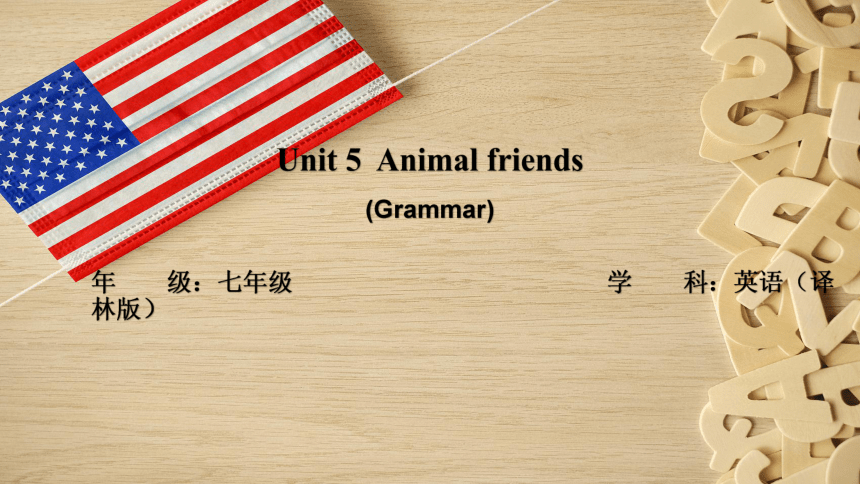 | |
| 格式 | pptx | ||
| 文件大小 | 7.4MB | ||
| 资源类型 | 教案 | ||
| 版本资源 | 译林版 | ||
| 科目 | 英语 | ||
| 更新时间 | 2025-08-16 11:41:04 | ||
图片预览

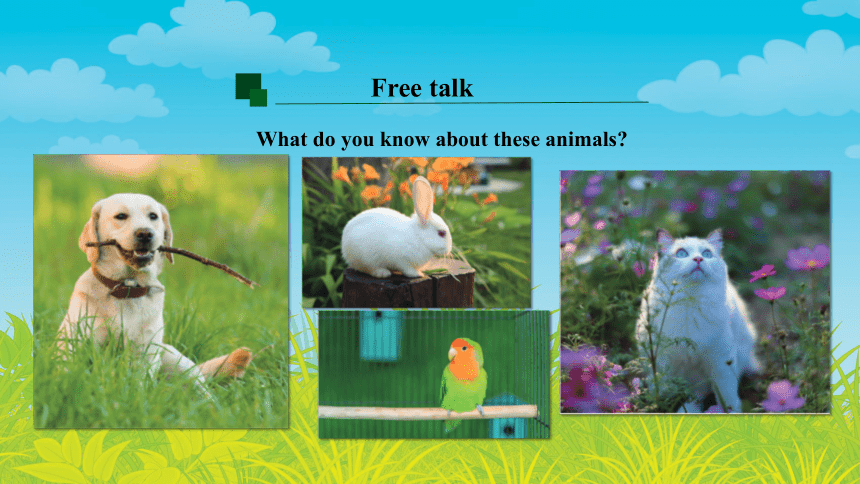
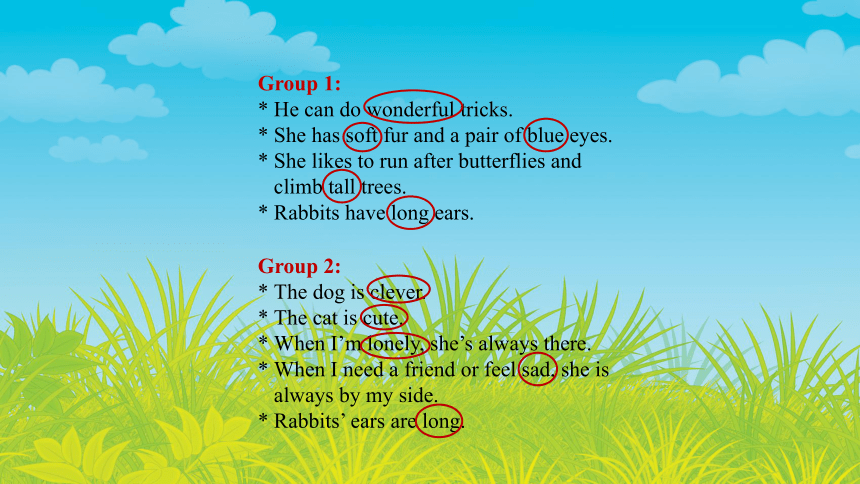
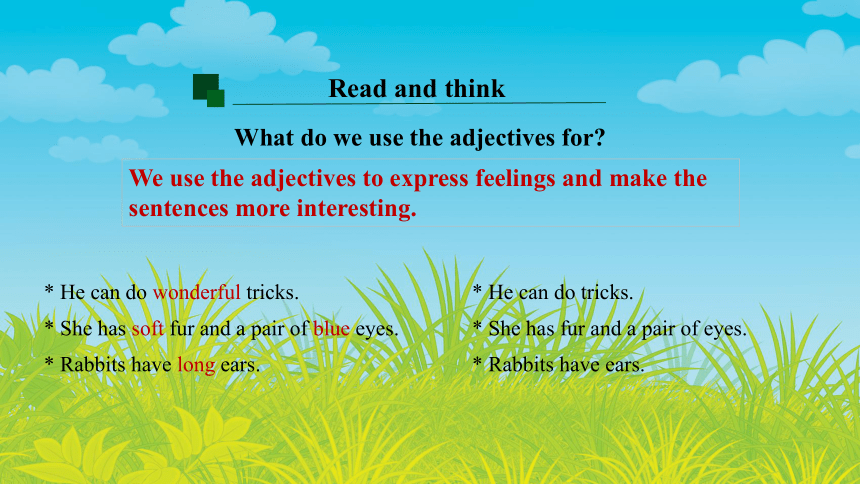
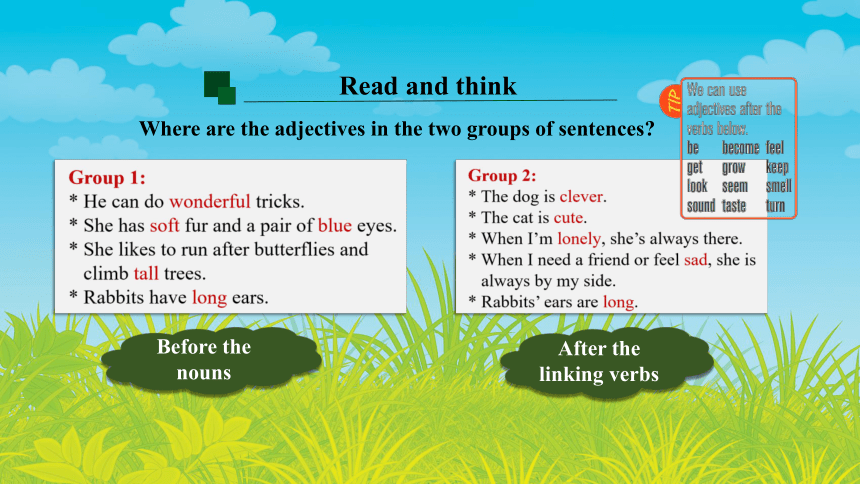
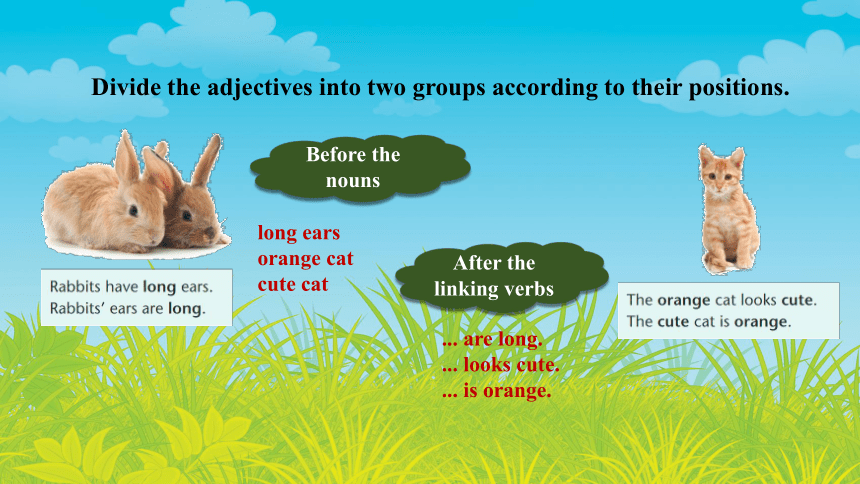
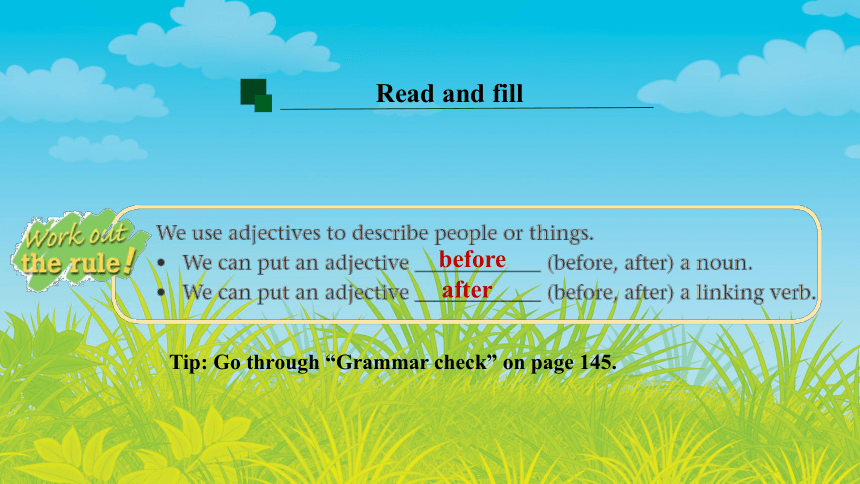
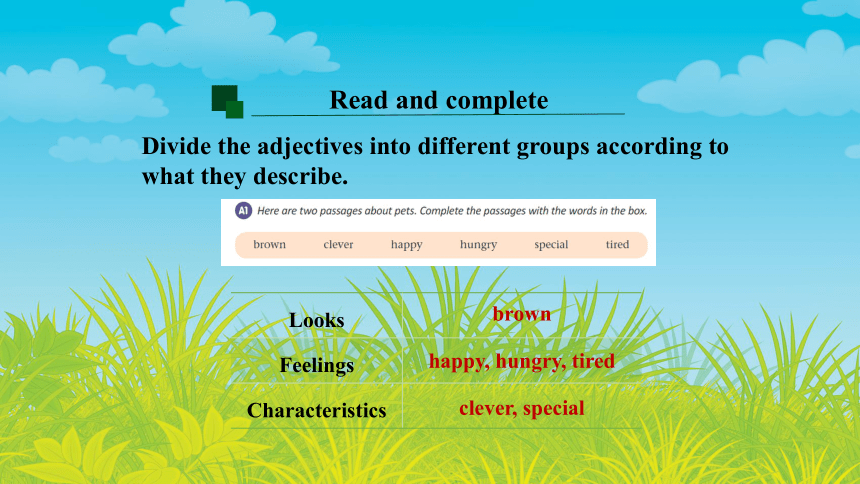
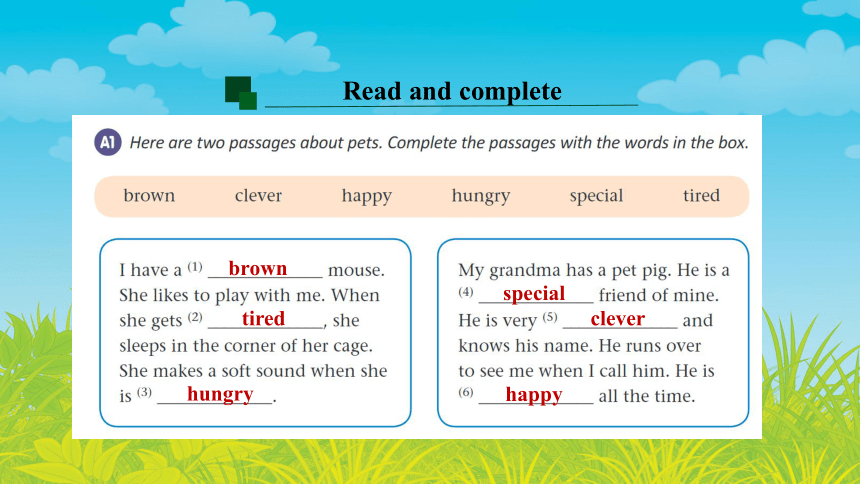
文档简介
(共25张PPT)
Unit 5 Animal friends
(Grammar)
年 级:七年级 学 科:英语(译林版)
Free talk
What do you know about these animals
Group 1:
* He can do wonderful tricks.
* She has soft fur and a pair of blue eyes.
* She likes to run after butterflies and
climb tall trees.
* Rabbits have long ears.
Group 2:
* The dog is clever.
* The cat is cute.
* When I’m lonely, she’s always there.
* When I need a friend or feel sad, she is
always by my side.
* Rabbits’ ears are long.
* He can do wonderful tricks.
* She has soft fur and a pair of blue eyes.
* Rabbits have long ears.
* He can do tricks.
* She has fur and a pair of eyes.
* Rabbits have ears.
Read and think
What do we use the adjectives for
We use the adjectives to express feelings and make the sentences more interesting.
Read and think
Where are the adjectives in the two groups of sentences
Before the nouns
After the linking verbs
Divide the adjectives into two groups according to their positions.
Before the nouns
After the linking verbs
long ears
orange cat
cute cat
... are long.
... looks cute.
... is orange.
Read and fill
before
after
Tip: Go through “Grammar check” on page 145.
Read and complete
Divide the adjectives into different groups according to what they describe.
Looks
Feelings
Characteristics
brown
happy, hungry, tired
clever, special
Read and complete
brown
tired
hungry
special
clever
happy
brown
tired
hungry
special
clever
happy
Add more adjectives to the two passages to make them more vivid.
little
small
cute
and lively
Read and talk
Make sentences about them, using adjectives.
A tiny yellow bee is flying around yellow flowers.
An orange cat is sitting there.
A curious boy is watching a beautiful goldfish inside the tank.
A man is walking his brown dog.
What can the animals in the pictures do
The bee can make less than one gram of honey in its life.
The cat can jump high and climb trees.
The goldfish can swim.
The dog can do wonderful tricks.
Can means “be able to do something” or “know how to do something” at present.
—Could your dog do wonderful tricks when he was young
—No, he couldn’t. But he can do them now.
Could means “be able to do something” or “know how to do something” in the past.
Read and finish
4
Read and finish
Where is can in the yes-no questions
At the beginning of a sentence.
Sum up
Modal verb Function Example
Can Talk about present ability * The parrot can talk.
* The parrot cannot/can’t talk.
* —Can your parrot talk
—Yes, she can./No, she cannot./No, she can’t.
Could Talk about ability in the past * The cat could jump really high when she was young.
* The cat could not/couldn’t jump really high when she was young.
* —Could your cat jump really high when she was young
—Yes, she could./No, she could not./No, she couldn’t.
What do could and can mean in this group
politely ask for permission to do something
give permission
How can we deny permission
No, … cannot./No, … can’t./Sorry, I’m afraid … can’t.
What do may and can’t mean in this group
ask for permission to do something
deny permission
How can we give permission
No, … cannot./
No, … can’t./
Sorry, I’m afraid … can’t.
Yes, … may.
politely ask for permission to do something
ask for permission to do something
May is more formal.
Read and finish
4
3
Sum up
Modal verb Function Example
Could Politely ask for permission —Could I play with your dog
—Yes, you can./
No, you cannot./No, you can’t./Sorry, I’m afraid you can’t.
May Formally ask for permission —May I feed your goldfish
—Yes, you may./
No, you cannot./No, you can’t./Sorry, I’m afraid you can’t.
Tip: Go through “Grammar check” on page 146.
Complete the sentences using can, could and may. Add not if necessary.
(1) —_______________ I feed your goldfish some food
—Sorry, I’m afraid you _______________. I just fed them.
(2) I’d like to read the poem about the pet dog. The only problem is I
_______________ find my glasses.
(3) Now, Fred _______________ write a poem about his favourite animal, but
he couldn’t do it last year.
(4) When my parrot was young, she could understand my words, but she
_______________ speak it.
couldn’t
May/Can/Could
can’t
can’t
can
Can
can’t
can
could
can’t
May
Can means “be able to do something” or “know how to do
something” at present.
Can’t means “be not able to do something” or “not know how to do something” at present.
Could means “be able to do something” or “know how to do something” in the past.
May is used to ask for permission.
A: Hey, … ! Do you have …
B: Yeah, I have a … named/called …
A: Can he/she …
B: No, …
A: My … can … Could … do that
B: Yes. … could do that when …
A: May/Can/Could I play with your … next time
B: Sure!
Talk about animals
Homework
Compulsory homework:
1. Finish the exercises on the workbook.
2. Preview Pronunciation on page 63.
Optional homework:
Write 3-5 sentences to introduce the animals you know, using some adjectives and can, could and may.
感谢观看
Unit 5 Animal friends
(Grammar)
年 级:七年级 学 科:英语(译林版)
Free talk
What do you know about these animals
Group 1:
* He can do wonderful tricks.
* She has soft fur and a pair of blue eyes.
* She likes to run after butterflies and
climb tall trees.
* Rabbits have long ears.
Group 2:
* The dog is clever.
* The cat is cute.
* When I’m lonely, she’s always there.
* When I need a friend or feel sad, she is
always by my side.
* Rabbits’ ears are long.
* He can do wonderful tricks.
* She has soft fur and a pair of blue eyes.
* Rabbits have long ears.
* He can do tricks.
* She has fur and a pair of eyes.
* Rabbits have ears.
Read and think
What do we use the adjectives for
We use the adjectives to express feelings and make the sentences more interesting.
Read and think
Where are the adjectives in the two groups of sentences
Before the nouns
After the linking verbs
Divide the adjectives into two groups according to their positions.
Before the nouns
After the linking verbs
long ears
orange cat
cute cat
... are long.
... looks cute.
... is orange.
Read and fill
before
after
Tip: Go through “Grammar check” on page 145.
Read and complete
Divide the adjectives into different groups according to what they describe.
Looks
Feelings
Characteristics
brown
happy, hungry, tired
clever, special
Read and complete
brown
tired
hungry
special
clever
happy
brown
tired
hungry
special
clever
happy
Add more adjectives to the two passages to make them more vivid.
little
small
cute
and lively
Read and talk
Make sentences about them, using adjectives.
A tiny yellow bee is flying around yellow flowers.
An orange cat is sitting there.
A curious boy is watching a beautiful goldfish inside the tank.
A man is walking his brown dog.
What can the animals in the pictures do
The bee can make less than one gram of honey in its life.
The cat can jump high and climb trees.
The goldfish can swim.
The dog can do wonderful tricks.
Can means “be able to do something” or “know how to do something” at present.
—Could your dog do wonderful tricks when he was young
—No, he couldn’t. But he can do them now.
Could means “be able to do something” or “know how to do something” in the past.
Read and finish
4
Read and finish
Where is can in the yes-no questions
At the beginning of a sentence.
Sum up
Modal verb Function Example
Can Talk about present ability * The parrot can talk.
* The parrot cannot/can’t talk.
* —Can your parrot talk
—Yes, she can./No, she cannot./No, she can’t.
Could Talk about ability in the past * The cat could jump really high when she was young.
* The cat could not/couldn’t jump really high when she was young.
* —Could your cat jump really high when she was young
—Yes, she could./No, she could not./No, she couldn’t.
What do could and can mean in this group
politely ask for permission to do something
give permission
How can we deny permission
No, … cannot./No, … can’t./Sorry, I’m afraid … can’t.
What do may and can’t mean in this group
ask for permission to do something
deny permission
How can we give permission
No, … cannot./
No, … can’t./
Sorry, I’m afraid … can’t.
Yes, … may.
politely ask for permission to do something
ask for permission to do something
May is more formal.
Read and finish
4
3
Sum up
Modal verb Function Example
Could Politely ask for permission —Could I play with your dog
—Yes, you can./
No, you cannot./No, you can’t./Sorry, I’m afraid you can’t.
May Formally ask for permission —May I feed your goldfish
—Yes, you may./
No, you cannot./No, you can’t./Sorry, I’m afraid you can’t.
Tip: Go through “Grammar check” on page 146.
Complete the sentences using can, could and may. Add not if necessary.
(1) —_______________ I feed your goldfish some food
—Sorry, I’m afraid you _______________. I just fed them.
(2) I’d like to read the poem about the pet dog. The only problem is I
_______________ find my glasses.
(3) Now, Fred _______________ write a poem about his favourite animal, but
he couldn’t do it last year.
(4) When my parrot was young, she could understand my words, but she
_______________ speak it.
couldn’t
May/Can/Could
can’t
can’t
can
Can
can’t
can
could
can’t
May
Can means “be able to do something” or “know how to do
something” at present.
Can’t means “be not able to do something” or “not know how to do something” at present.
Could means “be able to do something” or “know how to do something” in the past.
May is used to ask for permission.
A: Hey, … ! Do you have …
B: Yeah, I have a … named/called …
A: Can he/she …
B: No, …
A: My … can … Could … do that
B: Yes. … could do that when …
A: May/Can/Could I play with your … next time
B: Sure!
Talk about animals
Homework
Compulsory homework:
1. Finish the exercises on the workbook.
2. Preview Pronunciation on page 63.
Optional homework:
Write 3-5 sentences to introduce the animals you know, using some adjectives and can, could and may.
感谢观看
同课章节目录
